 |
The Saint of the Day
Blessed Angelo of Acri – October 30
Prof. Plinio Corrêa de Oliveira
Biographical selection:
Angelo, who would be the great apostle of South Italy, was born in 1669 in Acri, Calabria. He was the son of a manual worker. He entered the Capuchins and was a missionary for 40 years until his death in 1739.
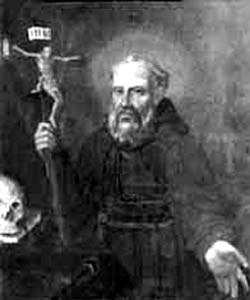
Blessed Angelo of Acri
All the photos are from www.beatoangelo.it
|
His sermons attracted thousands and the number of conversions he worked was impressive. He received a special grace to combat the evil of the errors of the philosophy of that century. His first sermon was supposed to be preached in Lent, and Angelo spent much time studying and preparing for it, planning its delivery in the florid oratorical style fashionable at the time. When he mounted the pulpit to give it, he forgot the text completely. It was a complete failure.
He returned to his home monastery and prayed to God to help him know what was expected of him. Then he heard a voice that told him: “I am He Who is. Do not be afraid. I will give you the gift of words, and your works will not be futile. From now on, preach in a simple and colloquial style so that all can understand you.” Angelo burned the sermons he had prepared, and made new ones following this directive.
His life was filled with fruitful works and miracles. He used to cross rivers and creeks without getting his feet wet; other times he would travel long distances in a miraculously short time to hear confessions of sick persons or to preach in far away villages. He became blind six months before his death, but would recover his sight to celebrate Mass and pray the Divine Office.
On October 30, 1739, at age 70, he delivered his soul to the Creator, Whom he had served tirelessly.
Comments of Prof. Plinio:
The life of Blessed Angelo of Acri offers us the profile of the Capuchin missionary that became famous, because that Order gave the Church many preachers like him. The Capuchin Order was one of the more avant-garde and efficient armies of the Counter-Revolution in the Church during the 18th century.
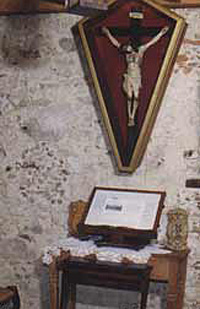
The faithful can visit the cell of Blessed Angelo in Acri, and venerate the miraculous crucifix, close-up below, that spoke to the Saint
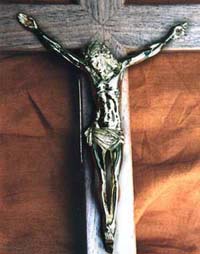
|
To understand the vocation of Blessed Angelo, it seems useful to summarize the qualities and the defects of the 18th century and see how the Capuchin Order had a special mission in those times.
At the end of 18th century, in 1789, the French Revolution took place in France and it went on until the defeat of Napoleon in 1815. There were, therefore, around 25 years of continuous revolution, one of the more important revolutions in History. But even before it erupted, the germs of that revolution had been present for a long time. Those germs came from Protestantism in the 16th century, developed for the next two centuries, exploding at the end of the 18th. Those germs contaminated principally the upper social classes.
On one hand, the 18th century reached a high point in some aspects of Christian Civilization. It was the century of elegance, distinction, good taste, and fine manners; it boasted great writers and artists; it attained a splendorous court life and perfected the art of conversation. To achieve all this was, in many ways, a work of asceticism, since it demanded an extraordinary prior preparation, discipline, and self-mastery; it was also a work of charity, because one’s neighbor was treated with the highest consideration.
On the other hand, in the 18th century the chasm widened between the more distinguished society and the Church. So, those good qualities born from Catholic Civilization were often corrupted by the impiety of the century. From this came the paradoxes: the century of delicacy was par excellence the century of hardness of heart and egotism. The century of elegance was also the century of softness and sentimentalism. It was the century of distinction of manners, but also the century of sensuality. In that century both the good qualities and the vices of Europe reached an apogee. Naturally, the vices surpassed the qualities, and we had the French Revolution.
The revolutionary tendencies promoted by the Secret Forces targeted principally the highest classes in society, that is, the clergy, the nobility, and the high bourgeoisie. It is painful to say, but the clergy was so influenced by the Enlightenment that it was not rare to find openly atheist and libertine priests and Bishops. They were persons who received ecclesiastic benefices and titles because they were prestigious and profitable. After receiving them, they continued to lead worldly and debauched lives. The convents were a little more moral than the monasteries, but even some of the former were also liberal. Some of these convents became a kind of hotel for noble women who did not marry. Noble families with numerous children often did not have the financial means to sustain them all, so they pressured the single daughters to enter the convents. Thus, many convents were filled with persons without religious vocations who received all kinds of worldly visits.
The nobility still maintained its old courage. They were very good fighters. They were brilliant gentlemen, but profoundly alienated from the practice of religion and given to the sensuality and intrigues of court. The ladies followed the same path.
The high and rich bourgeoisie tried to imitate the nobility. They were always looking for marriages with impoverished nobles to raise their social rank. The bourgeoisie, who had been very moral in the 17th century, also became contaminated by the defects of the nobility in the 18th century.
But the little people, the simple manual workers and peasants, were still preserved in their morals. Their milieu was not penetrated by the Enlightenment of the 18th century. At that time, there were not the great cities we have today. Paris, if I am not mistaken, had around 300,000 inhabitants, and was perhaps the largest city in the West. Rome was smaller, and Naples, the capital of the Kingdom of the Two Sicilies, was smaller yet. Blessed Angelo of Acri carried out his apostolate in Calabria and Sicily, parts of the Kingdom of Two Sicilies. At the time, the majority of the population lived either in small cities or in the countryside, and was very preserved.
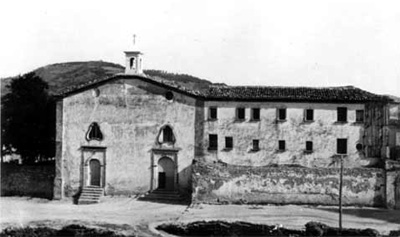
The old Capuchin monastery in Acri.
Below, the city of Acri
and the Basilica dedicated to him in the 19th century
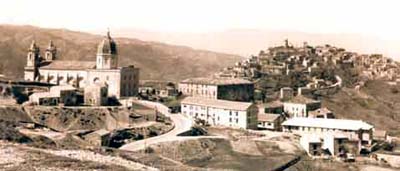
|
For the cause of the Counter-Revolution, it was very important to work with the little people to keep them practicing the Faith and far away from the errors of the elites. To that effect, God made use of an old order in the 18th century, the Order of the Capuchin Friars.
The Capuchins were the most severe branch of the Franciscan family. Its preachers were missionaries who worked with the village folk. Therefore, they spoke simply and clearly. They used to tell the whole truth to the people, without cloaking their words in ornate language. They were called to represent the virtues that the century denied: simplicity, honesty, frankness, courage to stand against the fashions and public opinion. In effect, the Capuchin Order shone in the 18th century for these qualities and helped to prevent the lower classes from adhering to the Revolution.
You heard that Blessed Angelo, who was himself a man of the people, tried to make a grand, complicated sermon. But Divine Providence gave him a lesson. His well prepared sermon was a complete failure. After he prayed, God told him what he should do. God did not want elaborate, flowery sermons, but simple sermons saying exactly what should be said. He told Blessed Angelo to address the people and say things that they could follow, that is to say, based more on piety than on complex reasoning. God made the apostolate of Blessed Angelo fruitful and many conversions were worked through him. These conversions most probably came more from the example of his sanctity than from his arguments.
God also gave him the gift of miracles, and he worked extraordinary ones. The world considers it a great miracle – and rightfully so – that the Jews crossed the Red Sea without wetting their feet. Here you see that Blessed Angelo crossed rivers, torrents, and creeks many times without getting wet. You can imagine the impression this made on the little people in the villages and towns. They did not understand his apologetic arguments very well, but seeing him cross the river without getting wet, they would applaud and cry out in admiration: “God is among us!” Then, numerous conversions would take place.
Other times he would travel enormous distances on difficult roads in a short period of time. That is, he was transported in some miraculous way, probably by the action of Angels. The little people knew that no man on foot or horseback could make that trip in such a time. Again, they were strongly impressed and the word of his sanctity spread. His prestige grew and conversions followed.
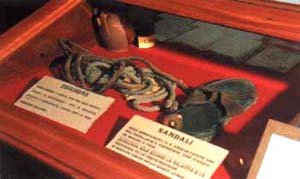
The sandals and belt, above, worn by the Capuchin Friar are preserved in a museum in his village
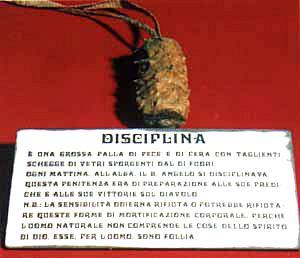
The discipline of Blessed Angelo of Acri
|
You can imagine the man wearing his simple Capuchin habit, representing his lack of any earthly pretension; on his belt around the waist was the rosary with a small skull to indicate that the Capuchin must always have death before his eyes; on his feet the simple worn sandals. His life followed the severe Capuchin rule that requires fasting and mortifications. He had a long beard and tonsure, both considered ridiculous by the sophisticated men of the 18th century.
This unpretentious friar enters a town to preach a mission. The people gather in a small church on top of a mountain in a village of Calabria or Sicily. The Mass is being said; there is beautiful singing. Then, at the Gospel, Friar Angelo goes to the pulpit. Before reaching the top of the stairs, he kneels and prays to God to illuminate him. Then he stands up without any airs and starts to speak.
His words, the selection says, had the strong, virile language that characterized the Capuchins, that is, they did not preach about the good, but attacked the evil: the evil that was infiltrating the customs of the little people. At times, they would stop in the middle of a sermon and say: “You there, my lady, you should not wear that kind of dress showing so much of your neck. Don’t you realize that this is an offense to God?” Or, by a special grace of God, they would read the thoughts of a person in the audience and say: “You, Mr. X, you are thinking this and this, but you are wrong, because it is against the will of God. You cannot hide anything from God, Who is showing me your thoughts even now.”
After having attacked the defects of the listeners, then a second part of the sermon would follow where they would describe the mercy of God, how He is good and has compassion for us. “Do not despair but confide in Him through the intercession of Our Lady.” This was the great tradition of the Capuchin sermons.
You can imagine the impact of this kind of sermon over the vivacious southern Italian people: Great contrition, tears, confessions, penances, and absolutions. After three or four days of a Capuchin preacher giving a mission in a village, the parish was regenerated. For months or even years those words would be remembered. The people would also recount the miracles of Blessed Angelo. One man who was feeble since he was a boy was blessed by Friar Angelo and was cured. Today he is a strong man capable of heavy work. Another man had been a bad husband for a long time, but Blessed Angelo spoke to him and from them on, he became an exemplary husband and father. The presence of the Capuchin remained in the locale for a long time, like a perfume, often for a whole generation.
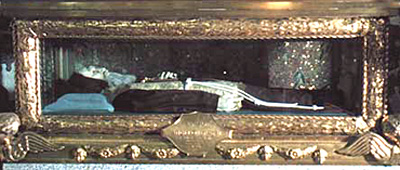
The incorrupt body of Blessed Angelo is venerated in the Basilica
|
The result was that among the people in southern Italy, a valorous counter-revolutionary movement was born, the Sanfedistas. The name comes from the title, “Defenders of the Santa Fede (Holy Faith).” This movement fought against the Revolution until recently. It was in Italy what the movement of the Vendée, the Vendeans, was in France. It represents the true right in Italy. The true right is not Fascism; this is the false right. The true right is represented by the Sanfedistas. The sermons and the sanctity of men like Blessed Angelo of Acri were what produced that movement, like the apostolate of St. Louis Grignion de Monfort produced the Counter-Revolution of the Vendée.
We should take the example of Blessed Angelo of Acri and the great Capuchin tradition as models, so that we will have the courage to face and fight the revolutionary ideas and fashions of our century. We should ask Blessed Angelo to help us to say what should be said for the glory of God and the exaltation of Holy Mother Church, and to be the opposite of the Revolution in our manners and way of living.


  | | Prof. Plinio Corrêa de Oliveira | |
The Saint of the Day features highlights from the lives of saints based on comments made by the late Prof. Plinio Corrêa de Oliveira. Following the example of St. John Bosco who used to make similar talks for the boys of his College, each evening it was Prof. Plinio’s custom to make a short commentary on the lives of the next day’s saint in a meeting for youth in order to encourage them in the practice of virtue and love for the Catholic Church. TIA thought that its readers could profit from these valuable commentaries.
The texts of both the biographical data and the comments come from personal notes taken by Atila S. Guimarães from 1964 to 1995. Given the fact that the source is a personal notebook, it is possible that at times the biographic notes transcribed here will not rigorously follow the original text read by Prof. Plinio. The commentaries have also been adapted and translated for TIA’s site.
|
Saint of the Day | Home | Books | CDs | Search | Contact Us | Donate

© 2002- Tradition in Action, Inc. All Rights Reserved
|
 |

|